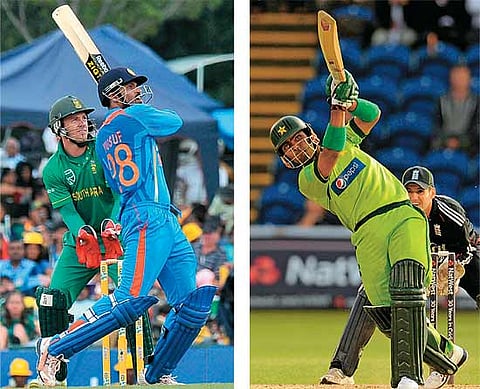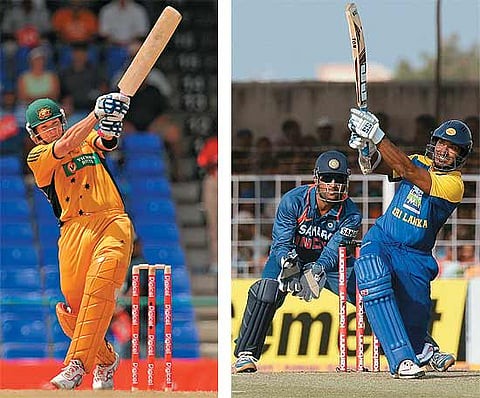Toss That Rupee Coin
There are no favourites, it’s anybody’s Cup this time. On six dark horses....
Since Hayden is no corporate entity trying to milk nationalism for profit (though he’s here flogging his recent book and trying to get a job with an IPL team), we must assume that the great Australian opener is really detecting equal red-hottedness in two teams simultaneously. Or he might well say, to lightly paraphrase the poet Walt Whitman, that if there’s a contradiction in his utterances, it’s because “the World Cup is vast, it contains multitudes”.
And he’d be right—the World Cup contains multitudes and that too without a king, for the empire is dead. Australia have won 23 World Cup matches in a row, but those days of certitude are gone, along with their array of great players. This time around, they’re likely to lose a match or two, perhaps in Sri Lanka, where they haven’t played a one-day international in seven years and where they have two key games in the group stage, against Sri Lanka and Pakistan.
In the past, only the West Indies and Australia have won the Cup as favourites; this time, in the fray are a bunch of near-equals, all of whom seem to have an equal possibility of winning the 10th World Cup. This really is the most open Cup since 1992, the last one with no one team in a stellar role. What does one make of a tournament in which six teams are favourites—and the same six are dark horses too?
“It’s clear that the days when one or two teams were completely dominant are over,” says former Test player Sanjay Manjrekar, talking to Outlook. “The West Indies won two in a row and were favourites for the next two; Australia won three in a row. I don’t see that pattern continuing.”

Yusuf Pathan India: Strike rate 134.95 His clean, powerful hits nearly beat SA in SA. (Photograph by AFP, From Outlook, February 21, 2011) | Umar Akmal Pakistan: Strike rate 84.34 The feisty colt knows only one gait: the gallop. (Photograph By Reuters, From Outlook, February 21, 2011) |
The order seems to be changing, but with lesser rapidity in ODIs. Australia have fallen down to No. 5 in the Test cricket rankings, but remain No. 1 in the 50-over game. In fact, if Hayden were to gauge their heat, he’d most likely find they’re white-hot, having just thrashed England 6-1 and finding hope after their Ashes annihilation. “Australia are on my list of contenders, on the basis of this performance,” Manjrekar says. They’ve won 17 out of 27 ODIs in the last one year, but the bad news for them lies hidden in the stats—only one of these games was played in the subcontinent, and they lost it, to India. They also went down twice to Sri Lanka who, like India, are more potent at home. And though Ricky Ponting, who hasn’t lost a single World Cup match as captain, is back after a break, they won’t have key batsman Michael Hussey, out with injury.
The support for Sri Lanka has an excellent reason grounded on the dubious principle of precedence—they’re the only team to win the event as hosts, though the final was won on foreign soil, at Lahore in 1996. Cricketing logic is a stronger index: their win/loss ratio (13/5, or 2.6) over the last one year is the best among all contenders. In the past year, they’ve won eight out of 12 ODIs at home, beaten every major team at least twice, and vanquished Pakistan in their only encounter. They have the astute Kumar Sangakkara at the helm, joined in the batting order by the explosive Tillakaratne Dilshan and the reliable Mahela Jayawardene. They have three Unconventional bowlers—Lasith Malinga, Muttiah Muralitharan and Ajantha Mendis—even as the art of bowling gets increasingly standardised elsewhere. “We have so much variety, which is important to keep other teams off balance,” says Sangakkara.

Dale steyn South Africa: Strike rate 34 (a wkt every 34 balls); on form, world’s best fast bowler now. (Photograph by AFP, From Outlook, February 21, 2011) | Kevin Pietersen England; Strike rate 86.68 Time to deliver in the Cup for England’s go-to man. (Photograph By Reuters, From Outlook, February 21, 2011) |
There’s a disagreeable truth in this stat too: eight of the wins were against weak West Indies and Zimbabwean teams; they barely won the series (3-2) against a supposedly much inferior Pakistan in Abu Dhabi; and they’ve lost and won four each against India, losing the series 1-2 in India in early 2010. Worse, Morkel and Steyn couldn’t stop India from reaching three massive totals, Steyn conceding 89 off 10 in one game. Finally, they too have not played a single ODI in Sri Lanka in close to seven years.

Chris Gayle West Indies; Strike rate 83.74 The coolest man in cricket is also among the most fiery. (Photograph by AFP, From Outlook, February 21, 2011) |
The sixth favourite (the darkest horse, according to many) is India, of course. An overwhelming number of experts and former cricketers believe they’re the team to beat. “They’re the favourites in my book,” says former Indian fast bowler Javagal Srinath. “They’ve been playing excellent cricket and their record at home in recent times is very good.” That’s certainly true—16 wins in 27 ODIs in the last 12 months and, more significantly, eight wins in nine matches at home. In Sri Lanka, they’ve won five and lost four matches. The bowling attack seems relatively weak, but on flat tracks on which even the word’s best bowlers struggle, batsmen win matches. And India probably have the most explosive line-up—Virender Sehwag, Yuvraj Singh, Suresh Raina, Yusuf Pathan, M.S. Dhoni, Gautam Gambhir and Virat Kohli. Then there’s Sachin Tendulkar, who’s topped 150 thrice in ODIs in the last two years, his last odi in India fetching him a nice, round 200.

Shane Watson Australia: Strike rate 85.71 Struck gold as opener, in fantastic form recently. (Photograph by AFP, From Outlook, February 21, 2011) | Kumar Sangakkara Sri Lanka; Strike rate 75.30 Cerebral captain, stylish demolisher. (Photograph by AP) |
“In a contest in which teams are very closely matched, India is the strongest team,” says Manjrekar. His views find a pleased, confident echo in the Indian cricketing fraternity. “This is probably our best opportunity to win the Cup,” former Indian captain Anil Kumble says. “Key players are in form, there are several all-rounders in the team, and the conditions are familiar.”
Miandad says India are the favourites; Kapil Dev says India can win; Imran Khan says they have a “slight” advantage. India seems to be upbeat that their team is a slight favourite, but perhaps it’s worth reflecting that only the West Indies in 1979 and Australia in 2003 and 2007 have won as favourites—and we’re talking about the two greatest demolition machines in the history of cricket. Non-favourites won in 1983, 1987, 1992, 1996 and 1999. No team has won on home soil. Sehwag, a shrewd thinker and plain speaker, has probably got it right, “I think it’s only when expectations are low that a team performs at its best.”
Kumble hopes India wouldn’t suffer through injuries, a factor vital among the bowlers during the first month which seems contrived by the sponsors. The first 42 matches are bereft of any cricketing meaning because at most they’ll help identify the eight quarter-finalists (see box). From then on, though, it will be a contest of equals, a race of dark horses cloaked as favourites, a race that seems too difficult to call.
- Of the batsmen who have scored over 1,000 runs overall in the World Cup, Viv Richards of the West Indies has the best average of 63.31 (1,013 runs) in 23 matches. Sachin Tendulkar is second with 57.93 (1,796 runs) from 36 matches.
- The highest batting average for batsmen with over 10 innings played or more is 124 by Lance Klusener in 11 innings from 14 matches—in which he was unbeaten eight times. The best for an Indian is Rahul Dravid, at 61.42. Klusener also has the best strike rate among batsmen who have faced at least 250 balls: 121.17.
- Stephen Fleming has captained New Zealand in 27 World Cup matches, a record. Mohd Azharuddin is second with 23, while Imran Khan and Ricky Ponting did the skipper’s job in 22 matches each.
- Australia and South Africa scored a total of 671 in 98 overs at an average of 6.84 in 2007 at Basseterre—the highest match aggregate in a World Cup match. Australia won.
- The highest team total in a World Cup match is India’s 413/5 (50 overs), against Bermuda at Port of Spain in 2007. It’s the only score over 400 in the World Cup. India won by 257 runs, the biggest margin of victory in a World Cup.
- Glenn McGrath holds the record for the most wickets—71 wickets from 39 matches; Wasim Akram has 55 from 38 matches and Muttiah Muralitharan 53 from 31. The most for an Indian is 44 from 34 matches by Javagal Srinath.
- New Zealand, Sri Lanka and England (twice) have all won games with just one ball remaining. But the tightest victory has been off the last ball, when Pakistan beat the West Indies at Lahore in ’87.
- Indians have been out in the 90s six times—Sachin Tendulkar (three times), Sourav Ganguly, Mohammed Azaharuddin and Navjot Singh Sidhu once each.
- The highest strike rate for an innings of at least 25 runs is 268.75, by Shoaib Akhtar, when he smashed 43 off 16 balls against England in 2003. The best for an Indian is 206.25, by Kapil Dev, with 33 off 16 balls against New Zealand in 1992.
- Anil Kumble, Dinesh Mongia and Virender Sehwag are among the seven players who have taken eight catches in one tournament. The record, though, stands with Ricky Ponting—11 catches in 11 matches in one World Cup.
- Many fielders and keepers have taken three catches in a World Cup match. But the record is held by an Indian—Mohammed Kaif—with four against Sri Lanka, in Johannesburg in 2003
- Sanath Jayasuriya, with 18 catches from 38 matches, is only next to Ricky Ponting, who holds the record with 25 catches in the 39 World Cup matches he has played. The best for an Indian? Anil Kumble’s 14 catches from 18 matches.
- The records for the 3 highest partnerships in World Cup matches are held by Indians. Sourav and Dravid (318), against Sri Lanka in 1999; Tendulkar and Sourav (244), against Namibia in 2003; and Dravid and Tendulkar (237), against Kenya in 1999.
- Ricky Ponting has a 100 per cent record as captain; he's won all 22 of the World Cup matches he's captained Australia in. Clive Lloyd led West Indies in 17 matches, winning 15, for a success rate of 88.23%. Both his defeats came against India in 1983. Sourav Ganguly, nine wins from 11 matches, had a 81.81% success rate as captain.
- Australia’s Adam Gilchrist holds the record for most dismissals by a keeper with 52 (45 catches, 7 stumpings) from 31 matches (1999-2007). Lanka’s Kumar Sangakkara is second with 32 (26, 6) off 21 matches. The best by an Indian is Kiran More with 18 (17, 1).
- Sachin Tendulkar has scored the most runs—1,796, with an average of 57.93, in 36 ODIs—in the World Cup from 1992 to 2007. Ricky Ponting is right behind, with 1,537 runs, at an average of 48.03, from 39 games, from 1996 to 2007.
- The World Cup will see a blitz of ad campaigns around skipper M.S. Dhoni, the highest earning cricketer in the world—he endorses over 20 brands. In 2010 he signed a three-year deal for Rs 210 crore.
Tags